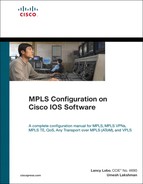Introduction
MPLS technology first emerged within the networking industry for IP core networks primarily as a mechanism to provide VPN services and traffic engineering capabilities. MPLS is now being extended toward the Metro-Ethernet/optical and access-network segments to extend the benefits realized in the core and provide a true end-to-end architecture for the delivery of packet data services.
The goal of this book is to familiarize readers with MPLS technologies and their configurations. The book provides a practical hands-on approach to MPLS-related technologies.
Who Should Read This Book?
The book is intended to cover basic and advanced MPLS concepts and configuration. The book does not just emphasize MPLS but also extends to applications and deployments associated with MPLS such as MPLS traffic engineering, Layer 2 VPN, and VPLS. This book can be used by anyone who wants to understand MPLS and its operation. This book can also be used by network engineers who configure and manage an MPLS-based network as well as for those engineers preparing for the CCIE Service Provider lab exam.
Overall, the book’s intent is to tremendously increase your awareness of the finer aspects associated with configuring MPLS and implementing it in various scenarios.
How This Book Is Organized
This book is meant to be read cover-to-cover for those who are new to MPLS; however, for intermediate to advanced users of MPLS, it allows you to move between chapters and sections of chapters to cover only the material that you need for additional information or for areas you are working with specifically.
The following is a summary of the chapter contents:
Chapter 1, “MPLS Overview”— Provides an introduction to MPLS theory and basic operation with coverage of what is a label and its function in MPLS. In addition, it covers the concepts of data plane and control plane and their operation in a cell-mode and frame-mode MPLS domain.
Chapter 2, “Basic MPLS Configuration”— Discusses configuration steps to configure cell-mode and frame-mode MPLS.
Chapter 3, “Basic MPLS VPN Overview and Configuration”— Covers fundamentals of MPLS VPN operation including multiprotocol BGP operation, VPN version 4 route exchange, and basic MPLS VPN configuration in the provider network.
Chapter 4, “PE-CE Routing Protocol—Static and RIP”— Discusses implementing MPLS VPN using static and RIP PE-CE routing.
Chapter 5, “PE-CE Routing Protocol—OSPF and EIGRP”— Discusses implementing MPLS VPNs using OSPF and EIGRP PE-CE routing protocols along with OSPF sham-link operation and configuration.
Chapter 6, “Implementing BGP in MPLS VPNs”— Covers concepts related to BGP PE-CE routing, configuring and implementing route-reflectors, as well as confederations in MPLS VPN networks. Theory and operation of BGP PE-CE for MPLS VPN hub-and-spoke implementations are also covered.
Chapter 7, “Inter-Provider VPNs”— Introduces inter-provider VPNs and discusses analyzing various options that can be used to provision inter-provider MPLS VPNs.
Chapter 8, “Carrier Supporting Carriers”— Discusses the concepts related to Carrier Supporting Carriers models. This chapter also discusses various CSC models such as customer carrier not running MPLS, customer carrier running MPLS, customer carrier providing MPLS VPN service, and benefits related to implementing CSC.
Chapter 9, “MPLS Traffic Engineering”— Covers Traffic Engineering basics, constraint-based routing and operation in MPLS TE, and configuring MPLS traffic engineering, as well as the mapping of customer MPLS VPN traffic to different TE tunnels. In addition, advanced features such as fast reroute link protection are also covered.
Chapter 10, “Implementing VPNs with Layer 2 Tunneling Protocol Version 3”— Covers concepts and configurations related to implementing Layer 2 VPNs over non-MPLS enabled provider networks using L2TPv3. In addition, the configuration to implement Layer 3 VPNs over L2TPv3-based provider architecture is also covered.
Chapter 11, “Any Transport over MPLS (AToM)”— Examines various modes of transporting Layer 2 protocols over MPLS. This chapter covers configuration of L2 VPN for like-to-like and any-to-any L2 technologies.
Chapter 12, “Virtual Private LAN Service (VPLS)”— Covers VPLS components and operation, VPLS configuration and verification, and VPLS topologies.
Chapter 13, “Implementing Quality of Service in MPLS Networks”— Covers the basics of MPLS QoS, and configuring and implementing Uniform and Short pipe mode operation.
Chapter 14, “MPLS Features and Case Studies”— Examines various MPLS features such as route target rewrite, Multi-VRF CE, VRF selection based on source IP address and policy-based routing, NAT and HSRP integration to MPLS VPN, Layer 2 VPN pseudowire switching and redundancy, class-based tunnel selection, and implementation of Layer 3 hierarchical VPNs over Layer 2 VPN infrastructure. In addition, the theory and configuration for implementing VPLS on a GSR as well as BGP Site-of-Origin are also covered.
In addition, you can find a bonus Chapter 15, “Testing MPLS” online at http://www.ciscopress.com/title/1587051990.
